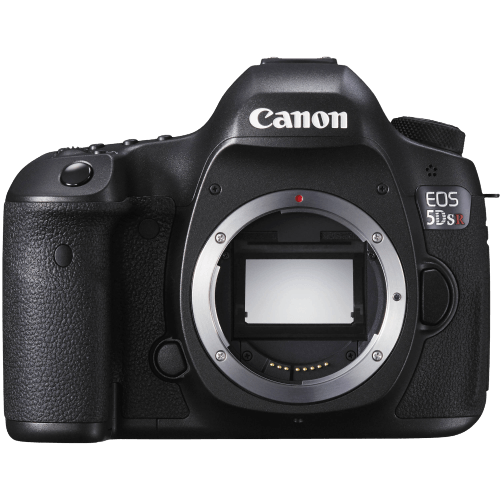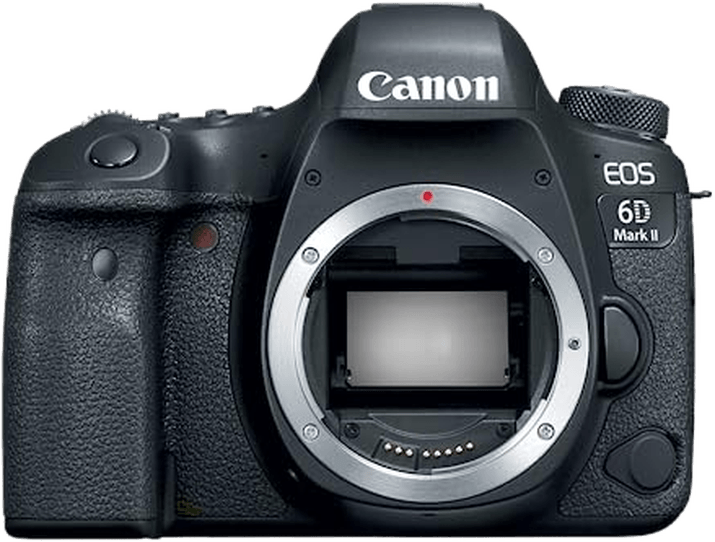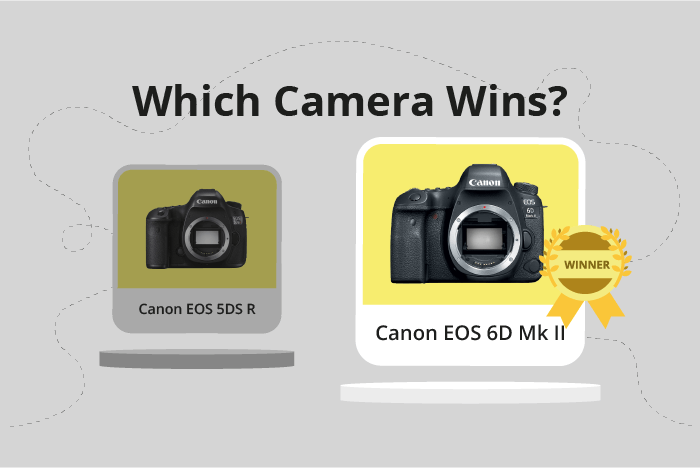Canon EOS 5DS R vs EOS 6D Mark II Comparison
Canon EOS 5DS R

Canon EOS 6D Mark II

The Canon EOS 6D Mark II takes the lead with a score of 71/100, while the Canon EOS 5DS R trails slightly behind with a score of 68/100. Both cameras are DSLRs, announced in 2015 and 2017 respectively. They share similar dimensions, with the 5DS R measuring 152 x 116 x 76mm and the 6D Mark II at 144 x 111 x 75mm.
The 6D Mark II excels with its lower launch price of $2000 compared to the 5DS R’s $3900. Additionally, it has the advantage of being lighter, weighing only 453g or 1.00lbs, while the 5DS R weighs 930g or 2.05lbs. This makes the 6D Mark II more affordable and portable for photographers.
Despite its lower score, the 5DS R still has some advantages. Its higher launch price implies more advanced features, and its larger size may provide better ergonomics for some users. Ultimately, the choice between these two cameras will depend on individual preferences and priorities in terms of budget, portability, and desired features.
Canon EOS 5DS R vs EOS 6D Mark II Overview and Optics
The Canon EOS 5DS R outperforms the Canon EOS 6D Mark II in optics with a score of 73 out of 100, compared to the 6D Mark II’s score of 69. Both cameras share certain specifications, including a CMOS sensor, full-frame sensor size, Canon EF lens mount, and the absence of image stabilization.
The 5DS R surpasses the 6D Mark II in terms of megapixels, boasting a remarkable 50.6 megapixels compared to the 6D Mark II’s 26.2 megapixels. This higher resolution allows for greater detail and image quality. Additionally, the 5DS R has a superior DXOMARK sensor score of 86, as opposed to the 6D Mark II’s score of 85, indicating a marginally better sensor performance. Furthermore, the 5DS R is equipped with Dual Digic 6 processors, enhancing its processing capabilities and overall performance.
In contrast, the Canon 6D Mark II has a faster shooting speed of 6.5 frames per second, compared to the 5DS R’s 5 frames per second. This makes the 6D Mark II more suitable for capturing fast-moving subjects or action photography. Additionally, the 6D Mark II features a newer Digic 7 processor, which may offer improved noise reduction and processing efficiency, despite having a lower DXOMARK score.
Taking these factors into account, the Canon EOS 5DS R is the superior choice for those seeking higher resolution and better sensor performance. However, the Canon EOS 6D Mark II may be more suitable for photographers prioritizing faster shooting speeds and action photography.
Canon EOS 5DS R vs EOS 6D Mark II Video Performance
The Canon EOS 5DS R and the Canon EOS 6D Mark II both have a video score of 57/100, making them equally capable in terms of video performance. Both cameras share common video specifications, including Full HD video resolution, 1920 x 1080 video dimensions, a maximum video frame rate of 30fps, and built-in time-lapse functionality.
Despite having the same video score, the Canon EOS 5DS R offers some advantages over the Canon EOS 6D Mark II. These advantages, however, are not related to video performance, as both cameras have identical video capabilities. Instead, the EOS 5DS R excels in other areas, such as image quality and resolution, which may be important for photographers who prioritize still images over video.
On the other hand, the Canon EOS 6D Mark II also has its own strengths. While it shares the same video capabilities as the EOS 5DS R, it may be a more suitable choice for photographers who value a balance between still image quality and video performance. The 6D Mark II is also known for its excellent low-light performance, making it a great option for shooting in challenging lighting conditions.
Both the Canon EOS 5DS R and the Canon EOS 6D Mark II are capable cameras in terms of video performance. Their identical video scores and specifications make it difficult to declare a winner in this category. Potential buyers should consider other factors, such as still image quality, low-light performance, and overall camera features, when deciding which camera best suits their needs.
Canon EOS 5DS R vs EOS 6D Mark II Features and Benefits
The Canon EOS 6D Mark II emerges as the winner in features, with a score of 83/100, compared to the Canon EOS 5DS R’s score of 59/100. Both cameras share some common specifications, such as a screen size of 3 inches (6D Mark II) and 3.2 inches (5DS R) and an identical screen resolution of 1,040,000 dots.
The 6D Mark II surpasses the 5DS R in several aspects, including a touchscreen, a flip screen, GPS, WiFi, and Bluetooth capabilities. These additional features make the 6D Mark II more user-friendly and versatile, allowing for easier navigation and enhanced connectivity with other devices.
In contrast, the 5DS R lacks these features, making it less convenient for users who seek advanced functionality and connectivity. However, it does have a slightly larger screen size of 3.2 inches compared to the 6D Mark II’s 3-inch screen, which may be preferable for some users who value a larger display.
To sum up, the Canon EOS 6D Mark II outperforms the Canon EOS 5DS R in terms of features, offering a more comprehensive and user-friendly experience with its touchscreen, flip screen, GPS, WiFi, and Bluetooth capabilities. On the other hand, the 5DS R has a marginally larger screen size, which could be an advantage for users who prioritize display size. Ultimately, the 6D Mark II’s higher feature score reflects its superiority in offering a more versatile and connected camera experience.
Canon EOS 5DS R vs EOS 6D Mark II Storage and Battery
The Canon EOS 5DS R outperforms the Canon EOS 6D Mark II in storage and battery with a score of 65/100 compared to the 6D Mark II’s 45/100. Both cameras accept SD/SDHC/SDXC (UHS-I compatible) memory cards and do not offer USB charging. However, the 5DS R boasts two memory card slots, while the 6D Mark II has only one. This advantage allows the 5DS R to store more photos and videos and provides backup storage options.
The 6D Mark II excels in battery life, offering 1200 shots per charge compared to the 5DS R’s 700 shots. Both cameras use the same battery type, LP-E6, but the 6D Mark II features an enhanced version, the LP-E6N, which contributes to its longer battery life.
In terms of storage and battery, the 5DS R’s dual memory card slots make it the superior choice for those who prioritize storage flexibility. However, the 6D Mark II’s longer battery life may be more appealing to photographers who require extended shooting sessions.
Canon EOS 5DS R vs EOS 6D Mark II – Our Verdict
Are you still undecided about which camera is right for you? Have a look at these popular comparisons that feature the Canon EOS 5DS R or the Canon EOS 6D Mark II:

